
Amphipolis was an important ancient Greek polis (city), and later a Roman city, whose large remains can still be seen. It gave its name to the modern municipality of Amfipoli, in the Serres regional unit of northern Greece.
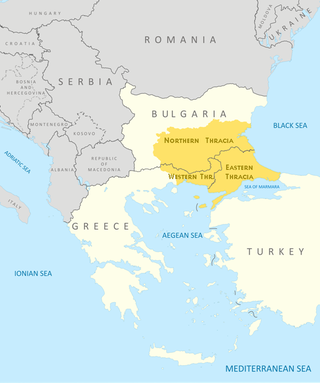
Thrace is a geographical and historical region in Southeast Europe. Bounded by the Balkan Mountains to the north, the Aegean Sea to the south, and the Black Sea to the east, it comprises present-day southeastern Bulgaria, northeastern Greece, and the European part of Turkey, roughly the Roman Province of Thrace. Lands also inhabited by ancient Thracians extended in the north to modern-day Northern Bulgaria and Romania and to the west into Macedonia.
Tourism in Bulgaria is a significant contributor to the country's economy. Situated at the crossroads of the East and West, Bulgaria has been home to many civilizations: Thracians, Greeks, Romans, Eastern Romans or Byzantines, Slavs, Bulgars, and Ottomans. The country is rich in tourist sights and historical artifacts, scattered through a relatively small and easily accessible territory. Bulgaria is internationally known for its seaside and winter resorts.

The Thracians were an Indo-European speaking people who inhabited large parts of Southeast Europe in ancient history. Thracians resided mainly in Southeast Europe in modern-day Bulgaria, Romania, and northern Greece, but also in north-western Anatolia in Turkey.

A kurgan is a type of tumulus constructed over a grave, often characterized by containing a single human body along with grave vessels, weapons and horses. Originally in use on the Pontic–Caspian steppe, kurgans spread into much of Central Asia and Eastern, Southeast, Western and Northern Europe during the 3rd millennium BC.

A tumulus is a mound of earth and stones raised over a grave or graves. Tumuli are also known as barrows, burial mounds or kurgans, and may be found throughout much of the world. A cairn, which is a mound of stones built for various purposes, may also originally have been a tumulus.
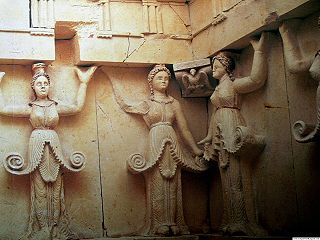
The Thracian Tomb of Svestari is 2.5 kilometers (1.6 mi) southwest of the village of Sveshtari, Razgrad Province, which is 42 kilometers (26 mi) northeast of Razgrad, in northeast Bulgaria. The tomb is probably the grave of Dromichaetes who was a king of the Getae on both sides of the lower Danube around 300 BCE, and his wife, the daughter of King Lysimachus who was a general and diadochus of Alexander the Great. The tomb is a UNESCO World Heritage Site.
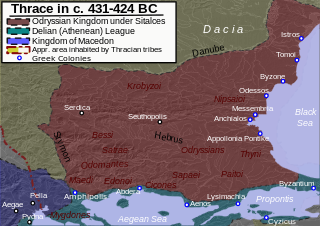
The Odrysian kingdom was an ancient Thracian state that thrived between the early 5th century BC and the early 3rd / late 1st century BC. Located in present-day Bulgaria, southeastern Romania, northern Greece and European Turkey, it was a tribal amalgam dominated by the Odrysians that was the first large political entity to develop in the eastern Balkans.
Dromichaetes was king of the Getae on both sides of the lower Danube around 300 BC.

Georgi Kitov was a Bulgarian archaeologist and thracologist. He specialized in Thracian archaeology. He participated in the excavations of many sites including the Alexandrovo Tomb, Kosmatka, Svetitzata and Starosel Cult Complex.
Cersobleptes, was son of Cotys I, king of the Odrysians in Thrace, on whose death in September 360 BC he inherited the throne.
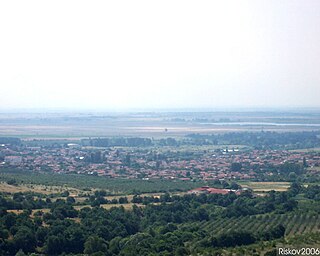
Starosel is a village in central Bulgaria, Hisarya Municipality, Plovdiv Province. It lies at the foothills of the Sredna Gora mountain range along the shores of Pyasachnik river.

The Thracians were a group of Indo-European tribes inhabiting a large area in Central and Southeastern Europe, centred in modern Bulgaria. They were bordered by the Scythians to the north, the Celts and the Illyrians to the west, the Greeks to the south, and the Black Sea to the east.

Seuthes III was a king of Odrysia, a part of Thrace, during the late 4th century BC.
Seuthes IV was a possible king of the Odrysians in Thrace during the 3rd century BC. Seuthes IV is an obscure figure, and the little that is known depends on inference from very limited information that may apply to him or others of the same name. Roigos, son of Seuthes, buried in the Kazanlăk Tomb, may be identified as the son of Seuthes IV, if Roigos and his tomb date to the mid-3rd century BC ; if, on the other hand, Roigos belongs in the early 3rd century BC, he could be identified as an otherwise unattested son of Seuthes III instead. In 2007, the Bulgarian archaeologist Georgi Kitov and his team excavated a Thracian burial mound known as Dalakova Mogila near the village of Topolčane near Sliven. The burial was of a royal or aristocratic warrior, buried in relative hurry with military equipment including an arrow-pierced silver helmet, a golden pectoral, various other vessels, many of them of gold, and a gold ring bearing the inscription that was eventually determined to read "Seuthes son of Teres" alongside a depiction of the owner as a bearded mature man with a possibly receding hairline. The date of the burial is uncertain. If it belongs to the 5th century BC, the Seuthes in question could be a son of the obscure Teres II, who was a contemporary of Seuthes II's father Maesades. A 4th-century BC date could make the Seuthes of the ring a son of Teres III, but he appears to be distinct from the famous Seuthes III who appears to have been buried elsewhere. An early 3rd-century BC date could make this Seuthes the son of Seuthes III's son Teres.

The Borovo Treasure, also known as the Borovo Silver Treasure, is a Thracian hoard of five matching silver-gilt items discovered in late 1974 while ploughing a field in Borovo, Bulgaria.
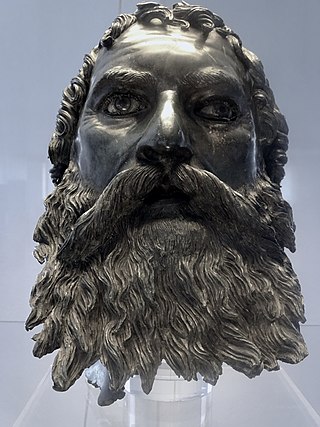
The Tomb of Seuthes III is located near Kazanlak, Bulgaria. Seuthes III was the King of the Odrysian Kingdom of Thrace from c. 331 to c. 300 BC and founder of the nearby Thracian city of Seuthopolis.

Golyama Arsenalka mound is a Thracian burial tumulus with a subterranean stone building near the Bulgarian town of Shipka. It dates from the end of 5th century BCE.

The Valley of the Thracian Rulers is a name which was made popular by the archaeologist Georgi Kitov and describes the extremely high concentration and variety of monuments of the Thracian culture in the Kazanlak Valley in Bulgaria. It is believed that there are over 1500 tumuli in the region, with only 300 being researched so far.

The Mogilan mound or Mogilanska mound is a burial mound in the center of Vratsa, Bulgaria.















